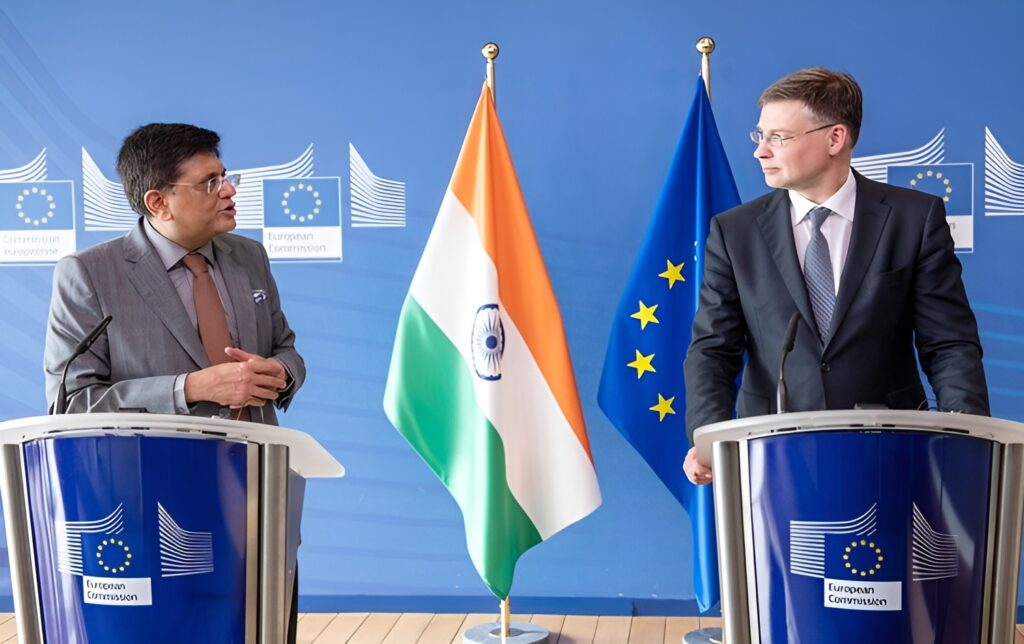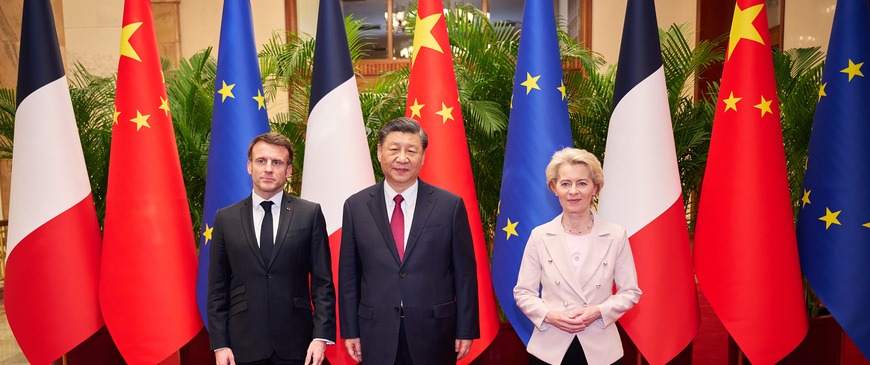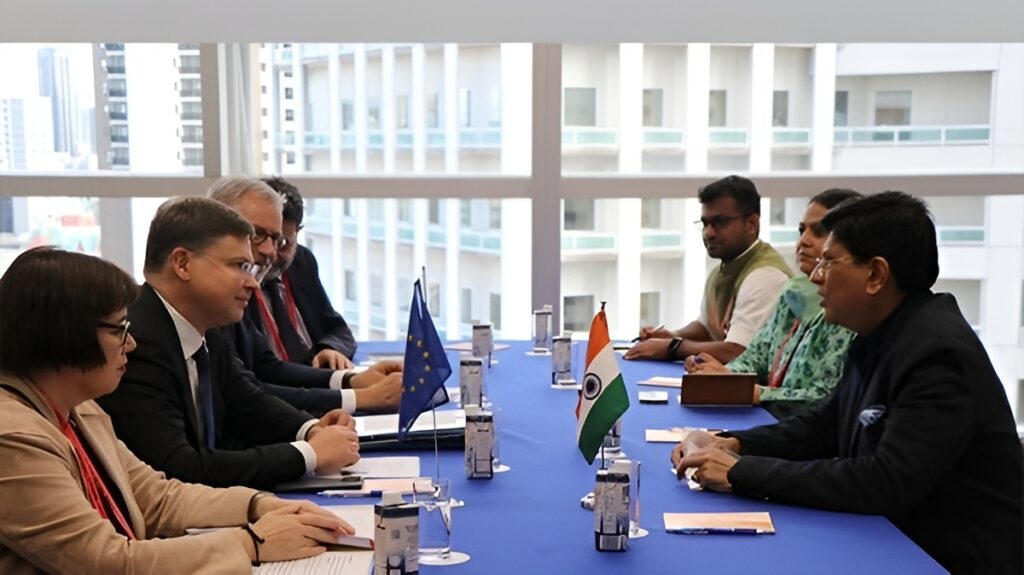Free Trade Agreement to change dynamics of EU-India Strategic Partnership
The dawn of 2024 has been marked by some significant developments, 2023 marked a year of historic milestones in India’s history that has captivated the nation and the world from cultural celebrations to scientific achievements. Capping the long list was that India hosted its first-ever G20 Summit presenting New Delhi with a unique opportunity to extend its leadership beyond the country’s borders at a time of increasing global economic uncertainty and turmoil.
Another major achievement of the year was the landing of Chandrayaan-3 on the moon’s lunar south polar region, the first-ever in the world. Among other milestones was also India becoming world’s most populous country, the country was also the fastest growing major economy of the world and the passage of Women’s Reservation Bill by the Parliament, in a new building that was opened earlier in the year.
Another significant development in the year gone by, in the eyes of Europe India Chamber of Commerce, the key EU-India trade body, was the progress in India’s free trade agreement negotiations with countries including European Union and Great Britain.
When Prime Minister Narendra Modi came to power in 2014, the first major decision that Modi government took was to cancel existing Investment Treaties with 50 countries. For some time, India struggled to convince the countries to accept the new investment treaties terms, but India finally succeeded in bringing the countries to see the reason behind the decision and the current FTA negotiations with EU and Britain has this investment clause enshrined as a trade policy.
Shifting goalposts

The EU has a history of taking decisions unilaterally that have hurt Indian trade in the past
Sixteen years ago, when India started free trade negotiations with the European Union, the policy issues being discussed included intellectual property rights, sanitary and phyto-sanitary standards, procurement policies and tariffs on wines, spirits and automobiles.
However, over the years, EU has changed the goalposts several times by bringing new non-trade issues, that led to the possibility of an agreement with India on the FTA appear more and more difficult. Changing goalposts and reluctance to accept India’s concerns was one of the key reasons behind the breakdown of negotiations in 2014.
After the resumption of negotiations, although the EU appears to be keenly interested in sealing the trade pact, its insistence on adding elements of its sustainability regime to the negotiations is complicating the discussions, and not just with India.
Bringing geographical indication, carbon tax, adding new policy clauses in climate and environment and other non-trade issues has led to a stalemate again. The Indian side has expressed concerns about EU’s green rules which clash with trade goals that India has been looking for. The sustainability requirements have added a new dimension in the negotiations and they are now a major stumbling block.
To make trade negotiations meaningful, it is important that EU reforms its trade policies with the developing world. EU’s double standards on trade are in fact a disgrace. It is no secret that EU forces developing countries to open their markets at a breakneck speed, while maintaining its own barriers to the Third World exports, particularly farm products and textiles. Not just by blocking agricultural imports from the developing world, the EU adds insult to injury by dumping its own highly subsidised agricultural surpluses in the developing world markets and with which small farmers from these countries cannot compete.
The EU has a history of taking decisions unilaterally that have hurt Indian trade in the past. It is necessary that India and EU follow common and accepted principles if they are serious about reaching an agreement. There is also a need to promote mutual understanding and trust between the parties, and both must search for mutually acceptable solutions on trade irritants.
Yet, despite the disputes, it seems that negotiations would proceed ahead in the current year as it appears that both parties have narrowed their differences on several “wish-lists” ranging from tariff on high-end IT products to lower tariff on agriculture products. The EU-India FTA is an economic imperative and a strategic necessity for EU and India, and a successful conclusion of the negotiation has the potential to significantly reshape the global economic order.
EU’s China policy: Recognise elephant in the room

European Union countries are struggling to agree with each other on the bloc’s China policy
Another significant issue over which Brussels appears completely clueless is its approach towards China. While strategic debates in Brussels and in the European capitals are focused on how to “de-risk” from China that balances EU’s trade engagement and strategic sustainability, policy makers in EU have failed to pay adequate attention to India’s emergence as a global power. EU has also missed the point that changing dynamics in the global order gives India a greater role in a range of geopolitical flashpoints which involve EU’s core interests.
The world is changing at a breath-taking speed and EU is not ready to face the challenges that this change brings along, making EU’s policies seem directionless. In order to sustain EU’s interest globally and in the Indo-Pacific especially, EU has to rebalance its economic relationships, moving from its over-reliance on China to recognising the critical importance that India holds for the EU.
European Union countries need to bring radical change in the way they work with China because they face an unbalanced competition with a country that uses its currency along with other instruments as leverages.
But there is also a policy catch. The EU is still not ready to provide specific parameters or a roadmap for its “de-risking” strategy from China. It has simply stated that “the European Union will continue to reduce critical dependencies and vulnerabilities, including in its supply chains, and will de-risk and diversify where necessary and appropriate”. After decades of pursuing limitless trade with China, EU is now pondering how much to “de-couple” and “de-risk” but the problem is that individual European Union countries are struggling to agree with each other on the bloc’s China policy.
Positive developments amid negotiation chaos

The FTA with EU will be the most important trade agreement that India will ink
If even after 16 years of negotiations, the FTA remains inconclusive it makes one think that EU and India may be close strategic partners but are hesitant free trade dreamers. Failing to clinch free trade pact will be a failure of trade diplomacy for both EU and India. More importantly, it will put a question mark on EU’s ability to negotiate a deal with the largest democracy.
Therefore, stakes are high for both and their ability to conclude negotiation. For EU it is the most valuable opportunity to establish itself as a reliable strategic partner. The FTA with EU will be the most important trade agreement that India will ink, and which will touch the lives of over 1.9 billion people in the two continents. With India set to become 3rd largest economy in the next five years replacing Germany, it makes sense for EU to embrace the moment.
Last year, EU took a significant decision to woo India in its race to “de-risk” its China ties by activating the Trade and Technology Council. The first such meeting attended by three ministers from the Government of India and four European Commissioners and dozens of officials scribbling notes on everything from semiconductor supply chains to artificial intelligence regulation, speaks a significant change in EU’s move to deepen its relations with India.
If letting Britain exit the European Union was an act of utter stupidity on part of the EU, it was also an act of deep betrayal on part of Britain. But EU’s loss was India’s gain. Britain quickly kick-started free trade negotiations with India and as reports suggest, both countries are within the touching distance to ink the pact. Britain’s Prime Minister Rishi Sunak having survived the “Rwanda Crisis” and Britain’s economy showing signs of recovery, there is a possibility that Sunak will soon travel to India to ink the pact.
He is keen to do this as he faces election in the next seven months, and he would like to capitalise his political fortune by inking the pact. India is expected to head to the polls in the next five months, in a mammoth election that is likely to see Prime Minister Narendra Modi secure a rare third term in power. The EU is closely watching the developments in New Delhi and London, as it knows that India will ask for the UK-India FTA framework to be replicated as a benchmark in EU-India FTA.
Those who have followed the internationalisation of global trade order and especially the FTA negotiations will know that free trade landscape is changing dramatically with four defining drivers namely technology, geopolitics, global exigencies, and climate change. In this context, a successful free trade framework will become a guiding principle for EU and India for their future trade negotiations also.
Free trade agreement is also a strategic need for EU and India because we have seen how during the health pandemic, global supply value chain was disrupted. Geopolitical risks and disruption in the value chain supply globally needs diversifying and improved access to newer trading patterns, including a free trade agreement. A successful conclusion of the negotiation has the potential to significantly reshape the global economic order as it will unlock mutual access for goods and investment in key areas such as digital markets, technology, critical raw materials and energy.
Diplomacy, including trade and economic diplomacy, is a practice that strives to creatively balance the pursuit of national interest with the interest of its trusted partners. The art of trade diplomacy is to maximise the benefits from the negotiations and at the same time become receptive to the concerns of partnering countries. India’s free trade negotiations with EU are therefore a litmus test for India’s resolve to stand up to its “existing positions” with “flexibility” in its approach.
As in diplomacy, trade diplomacy has no friends, only interests, and more aggressive the negotiating strategies with right mechanism, the less the chance for losing national interest in a trade deal. India is doing very well keeping its FTA negotiating partners in good humour with a message “Let us benefit together”. The challenge is whether the EU will get out of its slumber and shake hands on an agreement before it is too late?










